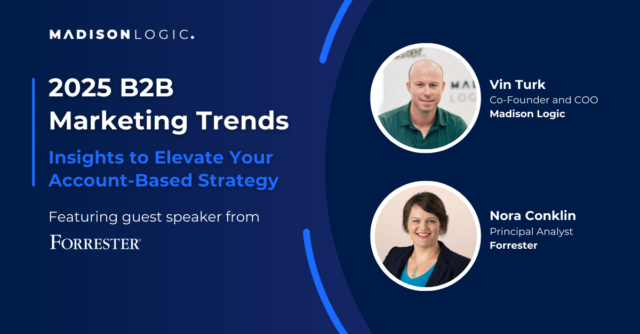
Back in January, we made a set of 2025 B2B marketing predictions about how B2B marketing would take shape in 2025. At the time, AI was the buzzword, younger buyers’ presence across buying committees was on the rise, and digital-first engagement was already shifting expectations. Now, halfway through the year, we have more than speculation—we have data that shows which trends are reshaping workflows for ABM and demand generation.
According to our recent survey conducted through The Harris Poll, 96% of marketing leaders say their teams have changed strategies in response to the current economy—whether by investing in AI, attending more events, or emphasizing flexibility in their messaging. Meanwhile, Forrester confirms that buyers are finalizing decisions earlier and relying more heavily on self-service and influence networks. These aren’t abstract trends. They’re redefining how account-based marketing (ABM) and demand gen marketers build campaigns, measure impact, and partner with sales.
Here’s what our five predictions look like now—and how to put them into action in the second half of 2025.
1. Unified Multi-Channel Interactions Are Emerging as the New Norm
Buyers expect consistency across every channel, and success in 2025 depends on your ability to orchestrate—not just participate—in the full buyer journey.
Forrester projects that more than half of $1M+ deals will be completed through digital self-service channels this year. At the same time, the Harris Poll shows 61% of marketers are leaning harder into events, both virtual (44%) and in-person (43%). Buyers are not choosing one path over the other—they’re moving fluidly between channels.
For ABM and demand gen teams, this shift forces a re-think of campaign design. Multi-channel orchestration is no longer an optimization—it’s a requirement. It’s not enough for your event strategy, marketplace presence, and ABM plays to exist in parallel. They need to be connected, data-backed, and aligned in messaging so that buyers experience a cohesive story at every touchpoint. Without that connective tissue, buyers feel the gaps—and accounts drop off before sales ever has a chance to engage.
What to Do Next: Map your buyer journey end-to-end. Can you follow an account from an in-person event to an on-site content hub to a marketplace interaction without losing the thread? If the answer is no, prioritize closing those gaps with integrated data and messaging before launching new campaigns.
2. Younger Buyers Are the New Power Players—and They Buy Differently
Millennials and Gen Z now dominate the B2B buying process, and they’re bringing new expectations around authenticity, influence, and digital-first experiences.
The Harris Poll found that 93% of marketing leaders recognize millennial and Gen Z marketers as changing the B2B landscape. Millennials are valued as digital natives who experiment with trends (55%), while 62% of respondents say Gen Z’s comfort with technology makes them especially effective at leveraging new marketing channels. These generational cohorts aren’t just influencing how marketing teams operate—they’re reshaping how buyers engage.
Marketers need to now consider how these younger buyers consume information. Short-form video, community-driven conversations, and peer-led storytelling matter more than a polished PDF. Just as importantly, younger buyers lean heavily on external influencers. More than half rely on ten or more outside voices when making purchasing decisions, according to Forrester. That means your account plans can’t stop at the buying committee. They must account for the network of voices that shape brand perception and influence how accounts evaluate their options.
What to Do Next: Expand your account plans to include external influence mapping and B2B influencer marketing. Identify the creators, communities, and thought leaders who matter to your top accounts—and build content kits designed to make it easy for them to share your story.
3. AI and Social Media Take Center Stage in Investment Plans
Artificial intelligence (AI) and social aren’t experimental anymore—they’re where budgets are going, and they’re reshaping how marketers personalize, target, and activate campaigns.
According to the Harris Poll, 57% of marketing decision-makers are investing more in AI tools for lead generation, content creation, and analytics. Another 43% are boosting influencer marketing spend, and 40% are increasing investment in podcasts and digital audio. Nearly all marketers (97%) say they’re excited about AI, especially for its ability to predict market trends (50%), improve data management (50%), and enable personalized video content (49%).
Many marketers are seeing the impact of AI in their daily workflows. AI makes it possible to create content variations at speed, tailor assets for buying stages, and connect intent data to predictive account targeting. Social and influencer campaigns, once seen as brand awareness plays, are now core to account activation. Video and audio content can’t live on the periphery of demand gen strategies—they must be integrated into ABM programs as scalable, personalizable formats.
What to Do Next: Establish clear AI guardrails in your team: what tools you’ll use, how outputs will be reviewed, and how you’ll measure impact. Then align your social creative calendar with ABM campaigns to ensure every channel tells the same story.
4. Patience with AI Is Emerging as the New Competency
The marketers who succeed with AI are the ones who treat it as a long-term investment, not a quick fix.
Enthusiasm for AI is sky-high—97% of marketers told the Harris Poll they are excited about AI adoption. But excitement alone doesn’t produce ROI. Forrester warns that companies chasing quick wins are already scaling back too soon, forfeiting the deeper value AI can deliver in trend prediction, data improvement, and scalable personalization.
Marketing teams need to set expectations across the organization and reframe AI adoption as a multi-quarter journey. The first wins will come in operational efficiency: faster content development, improved account prioritization, and streamlined reporting. Pipeline impact lags by necessity. B2B buying cycles are long, but once marketers understand how to optimize generative AI and their ABM content strategy, they will be able to launch campaigns faster and garner more demand through various assets. The marketers who communicate this clearly to stakeholders, with stage-specific key performance indicators (KPIs), will sustain investment and reap long-term gains.
What to Do Next: Build an AI roadmap for your program. Define KPIs for each stage—speed improvements this quarter, engagement quality by year-end, and pipeline velocity in 2026. Communicating incremental wins will keep leadership aligned on the bigger vision.
5. Infrastructure Over Quick Wins: Building for 2025 and Beyond
Intent data and RevOps maturity are separating winners from late movers. Without strong infrastructure, even the best campaigns won’t scale.
The Harris Poll reveals that 46% of marketers are using intent data more to personalize outreach, and 37% are narrowing focus to high-value accounts. These shifts align with Forrester’s emphasis on RevOps maturity as a core driver of growth in 2025. Marketers are moving from broad-based experimentation toward precise, account-focused strategies. But precision is only possible when data, systems, and processes are unified.
Infrastructure within an ABM framework is the foundation for everything else. Intent signals must flow seamlessly across your marketing automation platform (MAP), customer relationship manager (CRM), and ABM platforms to drive coordinated plays. Without it, high-value account targeting is just guesswork, and attribution stops short of proving full-funnel revenue impact.
What to Do Next: Operationalize intent data. Define specific workflows where account engagement triggers automated actions—ads, nurtures, or sales alerts—and ensure the resulting activity is tracked all the way to closed-won.
ABM Turns Predictions into Performance
Mid-year, it’s clear: our 2025 predictions weren’t just trends to watch—they’re realities that are reshaping ABM and demand gen. The marketers who succeed this year are the ones who aren’t chasing headlines but building orchestration, infrastructure, and patience into their programs.
2025 is no longer about predicting the future. It’s about proving you can operationalize it—and ABM is how you do it. You can optimize your ABM efforts by revisiting our 2025 B2B Marketing Predictions Guide and 2025 ABM Playbook. Then, contact us to discuss how a multi-channel ABM approach can help you reach your target accounts through 2025 and beyond with strategic insights from our ABM experts.


